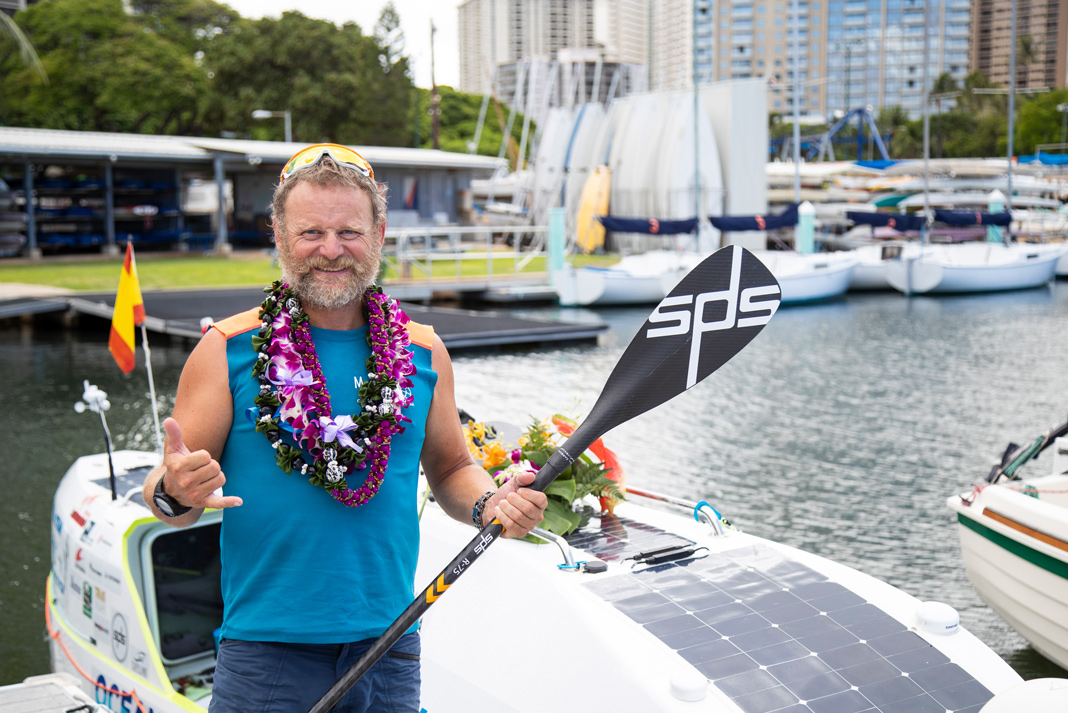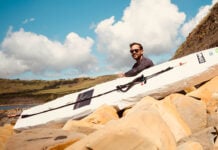Antonio de la Rosa had no clue he was attempting to retrace one of the greatest paddling voyages of all time when he arrived in San Francisco last June. He was preparing to paddle a custom-built, 24-foot standup paddleboard across the Pacific Ocean to Hawaii.
Only two days before his departure did de la Rosa, a Spanish adventure athlete, learn about Ed Gillet’s legendary 1987 sea kayak journey. Gillet was battered by storm waves and pushed off course by currents, before an extended period of calm dashed his hopes for making up distance by sailing. Long before the advent of satellite messengers, the San Diego-based Gillet was all but given up for dead. Then, miraculously, he touched down in Maui, fueled only by toothpaste after his provisions ran out. Even with the benefit of seriously modified equipment and modern communication technology, all recent attempts to match Gillet’s mythic 64-day crossing have failed—some more spectacularly than others.
Enter de la Rosa, 50, who got the idea of paddleboarding to Hawaii after winning the 2014 Rames Guyane, a grueling solo, unsupported trans-Atlantic rowing race, which marked the Spaniard’s first taste of open ocean travel.
To tackle the Pacific, he commissioned the construction of a 24-foot-long, 154-pound carbon-composite board—shaped like a peanut to facilitate paddling—yet with watertight storage and sleeping compartments fore and aft, respectively. The oversized SUP was equipped with a 65-pound daggerboard, a locking rudder and three solar panels, which were primarily used for charging a water desalinator. De la Rosa called it Ocean Defender—referencing his overarching expedition goal of documenting and raising awareness about ocean pollution.
A powerful ebb tide pulled de la Rosa seaward on his departure day, June 4, 2019. Launching in Marin, California, he was whisked by four-knot currents through the imposing gauntlet of the Golden Gate. De la Rosa, who completed a circumnavigation of the Arctic Circle by inflatable SUP in 2016, admits most of his efforts in preparing for the 2019 Pacific crossing went into the construction of his custom SUP.
“The technical preparation on this occasion was more important, along with the psychological gifts I was lucky to be born with,” de la Rosa says with a chuckle. He packed hundreds of pounds of freeze-dried and canned foods and trained his mental resolve for “absolute loneliness and self-sufficiency.”
Early on, de la Rosa was stifled by the California Current. He recalls several days of “great problems,” making incremental gains only to be pushed backward and off-course by the relentless southbound current. Once he escaped to the calmer waters of the open ocean, de la Rosa’s journey became easier. He was thrilled by the comfort of his custom board. “It was a 10,” he enthuses. “Without a doubt, it was the best design and construction we could do.”
As days turned to weeks and weeks turned to months, de la Rosa cleaned barnacles off the underside of his SUP three times. He admits he found “too much plastic”—sighting fishing nets and gear and other flotsam and jetsam every day. Finally, after 10 weeks at sea, de la Rosa glimpsed the mountains of Hawaii. It was a milestone signifying more challenges as the paddler was forced to endure sleepless nights maneuvering his board in high winds and waves towards an unforgiving coast.
Gillet was mistaken for a bedraggled bum when he limped ashore in Maui in 1987. De la Rosa, who regularly updated his Instagram feed with videos taken at sea, landed at Oahu’s Waikiki on his 77th day with much more fanfare.
His 2,950-mile crossing is second only to South African Chris Bertish’s 93-day, 4,050-mile SUP transit of the Atlantic Ocean in 2017. “I am feeling so good after 76 days in the middle of the ocean,” de la Rosa told a CNN reporter in Hawaii. Then he revealed his immediate plans to his 6,000 Instagram followers: burgers and beer.
Antonio de la Rosa arrives in Waikiki after more than two months at sea on his paddleboard, Ocean Defender. | Featured Photo: Tony Heff









